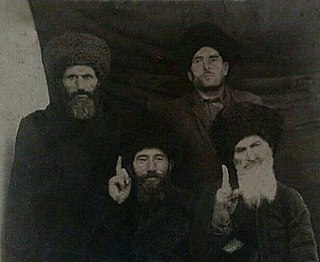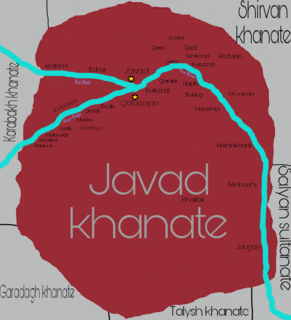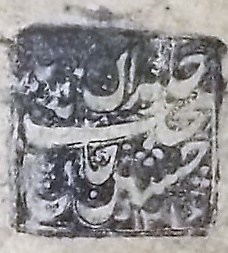
Khan from is a historic title originating among nomadic tribes in the Central and Eastern Eurasian Steppe to refer to a chief or ruler. It first appears among the Rouran and then the Göktürks as a variant of khagan and implied a subordinate ruler. In the Seljuk Empire, it was the highest noble title, ranking above malik (king) and emir (prince). In the Mongol Empire it signified the ruler of a horde (ulus), while the ruler of all the Mongols was the khagan or great khan. The title subsequently declined in importance. In Safavid dynasty it was the title of a provincial governor, and in Mughal India it was a high noble rank restricted to courtiers. After the downfall of the Mughals it was used promiscuously and became a surname. Khan and its female forms occur in many personal names, generally without any nobiliary of political relevance, although it remains a common part of noble names as well.

Lezgins or Leks are a Northeast Caucasian ethnic group native predominantly to southern Dagestan, a republic of Russia, and northeastern Azerbaijan. The Lezgin are predominantly Sunni Muslims and speak the Lezgi language.

The Karabakh Khanate was a semi-independent Turkic Caucasian khanate on the territories of modern-day Armenia and Azerbaijan established in about 1748 under Iranian suzerainty in Karabakh and adjacent areas.

The Quba Khanate was one of the most significant semi-independent khanates that existed from 1747 to 1806, under Iranian suzerainty. It bordered Caspian sea to the east, Derbent Khanate to the north, Shaki Khanate to the west, and Baku and Shirvan Khanates to the south. In 1755 the khanate conquered Salyan from the Karabakh Khanate.

The Shaki Khanate was one of the most powerful of the Caucasian Khanates established in Afsharid Iran, on the northern territories of modern Azerbaijan, between 1743 and 1819 with its capital in the town of Shaki.

Shirvan Khanate was a Caucasian khanate under Iranian suzerainty, which controlled the Shirvan region from 1761 to 1820.

The Nakhichevan Khanate was a khanate that was established in Afsharid Persia in 1747.

The Erivan Khanate, also known as Chokhur-e Sa'd, was a khanate that was established in Afsharid Iran in the 18th century. It covered an area of roughly 19,500 km2, and corresponded to most of present-day central Armenia, the Iğdır Province and the Kars Province's Kağızman district in present-day Turkey and the Sharur and Sadarak districts of the Nakhchivan Autonomous Republic of present-day Azerbaijan.
A khaganate or khanate was a political entity ruled by a khan, khagan, khatun, or khanum. This political entity was typically found on the Eurasian Steppe and could be equivalent in status to tribal chiefdom, principality, kingdom or empire.

Panah Ali Khan Javanshir was the founder and first ruler of the Karabakh Khanate under Persian suzerainty.

The khanates of the Caucasus, also known as the Azerbaijani khanates, Persian khanates, or Iranian khanates, were various provinces and principalities established by Persia (Iran) on their territories in the Caucasus from the late Safavid to the Qajar dynasty. The Khanates were mostly ruled by Khans of Turkic (Azerbaijani) origin and were vassals and subjects of the Iranian Shah. The khans neither had territorial or religious unity, nor a ethnic/national identity. They were mostly interested in perserving their positions and income.

The Javanshirs are a Turkic clan from Karabakh, who belong to the Afshar tribe and are in turn a branch of the Oghuz Turks. Between 1748 and 1822, members of the Javanshir clan functioned as the head of the Karabakh Khanate.

Khanchobany – is a national Azerbaijani dance, performed by men to fast national music.
Aghasi Khan (1731–88) was second Khan of Shirvan Khanate along with his brother Muhammad Said Khan. He was of nomadic tribe of Khanchobani.

Javad Khanate was a khanate in the territory of modern Azerbaijan with its capital in the town of Javad. It extended from Javad on the Kura River southwest along the east side of the Aras River. It was bordered by Shamakhy Khanate (north), Karabakh Khanate (west), Karadagh khanate (southwest), Talysh Khanate (south), and Salyan Sultanate (east).
House of Sarkar was ruling clan of Shirvan Khanate from Khanchobany tribe. "Sarkar" means "tax collector", which can give clues about profession of progenitor.
The Khalkhal Khanate was an 18th-19th century khanate based in Khalkhal. Khanate of Khalkhal was one of the khanates, located in historic Azerbaijan which remained semi-independent for 62 years.

Muhammad Hasan Khan was the fifth khan of Shaki.
Mirza Jamal Javanshir — was an Azerbaijani historian and politician, best known as the author of Tarikh-e Qarabagh .
Qasım Khan was the 7th Azerbaijani Shirvan Khan from 1789 to 1792.












